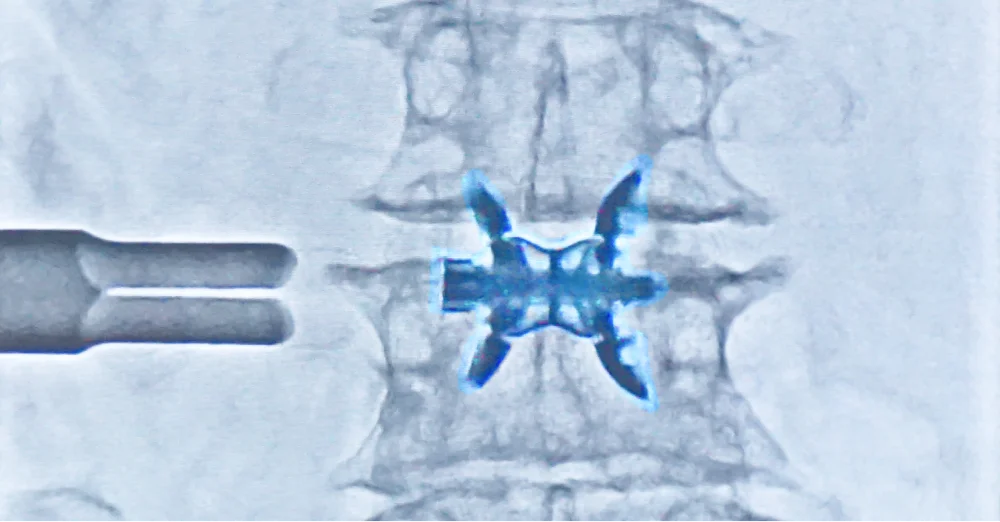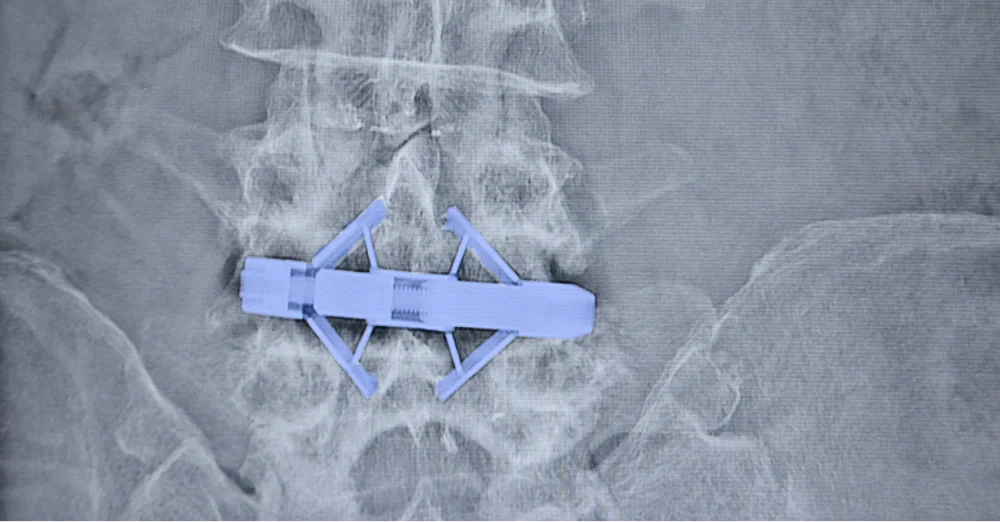August 12, 2025
When spinal instability occurs, spinal fusion surgery is usually the go-to procedure that is recommended to stabilize the spine.
Spinal fusion surgery is performed under general anesthesia and is a heavy procedure that places significant strain on the patient’s body. In contrast, minimally invasive techniques have been the subject of research and have increasingly been used in Europe in recent years.
This article will explain the current trends in spinal fusion.
What is spinal fusion surgery?
Spinal fusion surgery is a procedure that stabilizes the spine by fusing adjacent vertebrae together using screws or other implants when the spine is unstable or when instability is likely to occur following other surgeries.

The indications for spinal fusion
Fusion surgery is indicated for a wide range of conditions, including disc herniation, spinal stenosis, spondylolisthesis or spondylolysis, compression fractures, and scoliosis.
Research papers note that clear criteria for fusion indications in degenerative lumbar disease are lacking. Generally, indications include: “① Lumbar spondylolisthesis or intervertebral instability with significant preoperative instability, ② Refractory low back pain of discogenic origin, ③ Cases requiring correction due to poor spinal balance, ④ Cases where surgery necessitates iatrogenic laminectomy or facet joint resection, leading to reduced postoperative spinal stability.” *1
*1 Source: Toshiyuki Takahashi et al., “Spinal Fusion Surgery for Lumbar Degenerative Disease—Indications and Methods Including the Latest Fusion Techniques,” Journal of Neurosurgery, Vol. 24, No. 5, 2015.
Spinal fusion surgery procedure
Lumbar spinal fusion surgery is performed under general anesthesia. The procedure typically takes one hour or more.
An incision is made in the back. The length of the incision varies depending on the number of vertebral levels to be fused, but it is generally 3 cm or longer.
The spinous processes at the back of the spine are removed, along with part of the lamina. The intervertebral disc is removed while taking care to avoid the spinal cord. A cage made from the patient’s own bone is inserted to replace the removed disc. Following this, holes are drilled into the base of the laminae of the adjacent vertebrae above and below. Screws and rods are inserted and fixed in place with screws.


Risks and effectiveness of spinal fusion
At the same time, it restricts movement in the lumbar region. It is a highly invasive surgery, and the hospital stay is long, typically one to two weeks.
Complications associated with fusion surgery include fracture of the metal screws or other implants, paralysis due to spinal cord or nerve damage, increased stress on adjacent discs leading to herniation or spinal stenosis, and the risk of pus accumulation at the surgical site.
Recent trends in Europe: interventional radiology
In Europe, a new approach is increasingly replacing traditional surgical procedures. This is Interventional Radiology (IVR), a technique performed using catheters or needles while visualizing the body’s interior with imaging such as fluoroscopy or CT scans.
IVR (= image-guided therapy) was first developed as early as the 1960s for minimally invasive treatments of the heart and brain. Today, it is used not only for cardiovascular and brain diseases but also across a wide range of fields, including kidney and liver diseases, and gynecological conditions.
One medical field in which IVR is indicated is spinal disorders.
IVR as an alternative to spinal fusion: spinous process spacers
Spinous process spacers exist as an alternative between conservative treatments like medication and rehabilitation, and invasive surgical procedures requiring incisions. Minimally invasive procedures are considered a good option for patients who require treatment but are unable to undergo surgery.
Various spinous process spacers have been developed worldwide, with many physicians in Europe and the US performing procedures using Lobster or Q-Fusion.
The indications for spinous process spacers
Lobster and Q-Fusion spinous process spacers are procedures indicated for spinal stenosis, spondylolisthesis, and lumbar instability.
Procedures using Lobster or Q-Fusion are also effective for intermittent claudication—a characteristic symptom of spinal stenosis and spondylolisthesis. This condition involves pain or numbness in the legs during walking that prevents further walking, followed by immediate relief after a short rest, only for the pain to return after resuming walking.
Method for inserting the spinous process spacer
By inserting dedicated instruments (a Lobster spacer, or a Q-Fusion device) between the spinous processes, the narrowed spinal canal is widened. Opening the device’s wings stabilizes the unstable vertebrae.

The procedure is performed under local anesthesia and sedation. Using fluoroscopy, an incision between 2 to 3 cm is made on the side of the lower back. A thin, tubular dedicated instrument is inserted between the spinous processes of the lumbar vertebrae to be treated. The spacer is then delivered through this tube.


The procedure takes approximately 30 minutes per site, which is quite short. Patients can walk home on the same day. This differs significantly from conventional surgical procedures.
In Europe, procedures using Lobster or Q-Fusion are routine treatments, with 4 to 6 procedures performed daily.
Risks and effectiveness of the spinous process spacer
Inserting a specialized spacer between the spinous processes widens the narrowed spinal canal and stabilizes the spine, thereby improving symptoms such as lower back pain, leg pain, and numbness.
Unlike with traditional spinal fusion surgery, there are no restrictions on movements like bending, arching, or twisting the back.
Procedures using Lobster or Q-Fusion are minimally invasive treatments with low risk, and there are no reported cases of post-treatment complications or recurrence of the symptoms.
IVR image-guided treatment is only available at a single facility in Japan
ILC International Lumbago Clinic (in Tokyo, Osaka & Nagoya) is the only facility in Japan offering the cutting-edge procedures using Lobster and Q-Fusion.
If you suffer from low back pain and wish to avoid surgical intervention, please consider a consultation at our clinic.
Treatment Case Report No. 165| ILC International Lumbago Clinic (Osaka Clinic)
Treatment Progress Report No.178: A Patient That Came to See Us Following a Surgery



